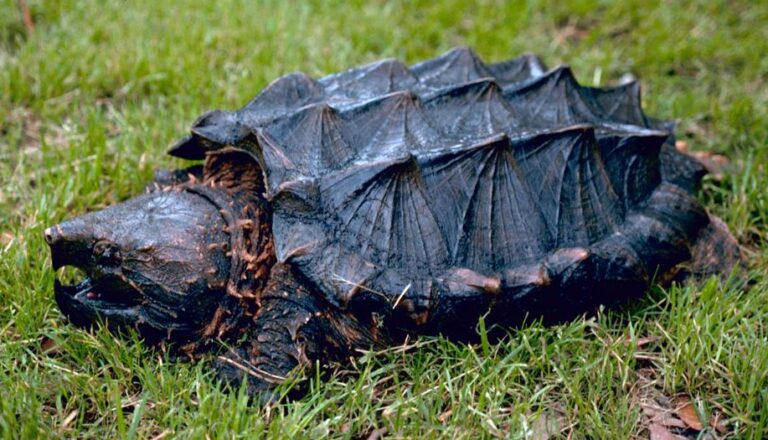Snapping turtles are a number of the most fascinating creatures that roam North America’s freshwater ecosystems. With their prehistoric appearance and specific conduct, they captivate every person who takes the time to observe them. This article delves into the sector of snapping turtles, exploring their biology, habitat, conduct, and the position they play of their surroundings.
A Look at the Snapping turtle’s Anatomy
Snapping turtles are regarded for their rugged and truly intimidating look. They own a large, muscular body blanketed with a difficult, ridged shell. The shell, or carapace, can range in coloration from brown to black, often covered with algae, making them combo seamlessly into their surroundings.
One of the maximum specific capabilities of the snapping turtle is its effective jaw. Unlike other turtles with flatter, greater passive jaws, the snapping turtle has a beak-like mouth capable of delivering a sharp, painful chew. This is an model that has advanced to help them catch and consume a huge type of prey, consisting of fish, amphibians, or even small mammals.
The tail of the snapping turtle is lengthy and saw-toothed, some other prehistoric trait that recommendations at the historic lineage of these reptiles. Their limbs are sturdy and prepared with webbed toes, helping them in swimming through murky waters. However, they’re not specifically speedy swimmers, depending greater on ambush techniques to catch prey.
Habitat and Distribution
Snapping turtles are often found in freshwater environments which includes ponds, lakes, rivers, and marshes. They are relatively adaptable and can thrive in quite a few aquatic habitats, from gradual-transferring rivers to stagnant swamps. Their range extends throughout a good deal of North America, from the southeastern United States up into southern Canada.
These turtles decide on habitats with gentle, muddy bottoms and considerable vegetation, which provide sufficient cover and looking possibilities. They are often seen lurking at the bottom of a water body, partly buried in dust or under aquatic flowers, waiting to ambush prey.
In less warm climates, snapping turtles hibernate during the iciness months. They bury themselves inside the dust at the bottom of a pond or river, wherein the water temperature stays tremendously stable. During this period, their metabolism slows appreciably, permitting them to continue to exist for months without eating.
Feeding and Behavior
The snapping turtle is an omnivore with a weight loss program that consists of a extensive type of food assets. They feed on fish, frogs, bugs, birds, small mammals, and even carrion. They also are recognized to eat aquatic flora, making them important individuals to the balance of their ecosystems.
Snapping turtles are in most cases ambush predators. They lie immobile in the water, expecting unsuspecting prey to come back inside reach. When they strike, they accomplish that with exquisite pace, the usage of their effective jaws to capture and weigh down their prey.
Interestingly, no matter their fearsome reputation, snapping turtles are generally no longer competitive towards people. They favor to avoid war of words and will commonly retreat when approached. However, if cornered or provoked, they are able to defend themselves with a effective bite.
Reproduction and Lifespan
Snapping turtles have a distinctly sluggish reproductive rate, which is one of the reasons why they may be vulnerable to overharvesting and habitat loss. Mating generally takes place inside the spring, shortly after the turtles emerge from hibernation. Males and girls interact in a courtship ritual that entails swimming in circles and biting each other’s tails and legs.
Females lay their eggs in late spring or early summer time, digging a hollow in sandy or muddy soil close to water. They can lay everywhere from 20 to forty eggs, which they then cover with soil. The eggs are left to incubate on their very own, and after approximately 80 to 90 days, the hatchlings emerge. The sex of the hatchlings is decided by the temperature of the nest, with hotter temperatures normally generating women and cooler temperatures producing males.
Once hatched, the younger turtles ought to make their manner to water, in which they start their solitary lives. They face severa predators, such as birds, raccoons, and fish, and very few make it to adulthood. Those that do can live for several a long time, with a few snapping turtles residing extra than forty years inside the wild.
Conservation and Threats
Despite their adaptability, snapping turtles face several threats. Habitat destruction is one of the maximum sizable demanding situations, as wetlands and other aquatic environments are drained or polluted. Road mortality is another concern, particularly during the nesting season when women are more likely to cross roads on the lookout for appropriate nesting web sites.
Overharvesting also poses a hazard to snapping turtle populations. In some regions, they’re looked for their meat, which is taken into consideration a delicacy. The gradual reproductive price of snapping turtles way that populations can be speedy depleted if now not controlled cautiously.
In reaction to these threats, conservation efforts had been applied in lots of regions. These encompass protecting crucial habitats, imposing street-crossing structures, and regulating the harvest of snapping turtles. Public education is also critical in converting perceptions of those misunderstood creatures and selling coexistence.
The Role of Snapping turtles within the Ecosystem
Snapping turtles play a crucial role in their ecosystems. As each predators and scavengers, they help manipulate populations of numerous species and make a contribution to the decomposition of dead animals. By feeding on aquatic plant life, in addition they help keep the fitness of wetland environments.
Moreover, snapping turtles function signs of environmental health. Because they’re lengthy-lived and gather toxins through the years, their presence (or absence) can offer valuable records about the kingdom of an environment. Protecting snapping turtles and their habitats isn’t always handiest vital for the species however for the broader fitness of aquatic ecosystems.
Conclusion
The snapping turtle is a great species with an extended and storied history. These ancient reptiles have survived for thousands and thousands of years, adapting to a huge variety of environments and gambling a crucial position of their ecosystems. However, they now face large threats from human sports. By knowledge and appreciating the snapping turtle, we can take steps to ensure that those captivating creatures keep to thrive inside the wild for generations to return.


